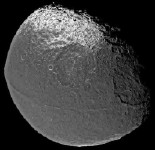A Mystery Orbits Saturn
...and its name is Iapetus.
On New Year's Eve, NASA's Cassini space probe conducted a flyby of Saturn's third largest moon, which has been a mystery since its discovery in 1672 (by the probe's namesake, Jean-Dominique Cassini). The surface of Iapetus is nearly pitch-black on one side, and snow white on the other. And no one knows why.
But rather than solving this mystery, the Cassini probe revealed another. It discovered a massive, inexplicable equatorial ridge spanning almost the entire circumference of the planet (808 of 890 miles, to be precise), that reaches heights of 12 miles - three times that of Mt. Everest.

Cassini will return to Iapetus in September, 2007, when it will be in position to take photographs of 100 times higher resolution.
I will be waiting.
On New Year's Eve, NASA's Cassini space probe conducted a flyby of Saturn's third largest moon, which has been a mystery since its discovery in 1672 (by the probe's namesake, Jean-Dominique Cassini). The surface of Iapetus is nearly pitch-black on one side, and snow white on the other. And no one knows why.
But rather than solving this mystery, the Cassini probe revealed another. It discovered a massive, inexplicable equatorial ridge spanning almost the entire circumference of the planet (808 of 890 miles, to be precise), that reaches heights of 12 miles - three times that of Mt. Everest.

Cassini will return to Iapetus in September, 2007, when it will be in position to take photographs of 100 times higher resolution.
I will be waiting.


































1 Comments:
I will also be waiting. The equatorial ridge is by no means the only anomalous feature imaged by Cassini on it's recent fly-by. There are many seemingly geometric features, which give the overall impression that Iapetus is not a natural formation. It is however, difficult to draw any conclusions from the images currently available. If JPL/NASA would release the radar data collected by Cassini on this fly-by, we would be in a better position to draw conjecture. I encourage all who read these comments to write to JPL/NASA and ask them to make the radar measurements available to the public.
Post a Comment
<< Home